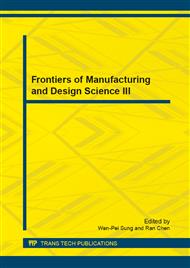p.1441
p.1446
p.1451
p.1455
p.1459
p.1463
p.1467
p.1473
p.1478
The Topological Optimization of High-Speed Vertical Machining Center Worktable
Abstract:
In this paper, high-speed vertical machining center of the four schemes(namely general reinforcement worktable, strength general reinforcement worktable, diagonal reinforcement worktable and strength diagonal reinforcement worktable) has been entity modeling in Soldworks. After modeling, do finite element analysis and stiffness analysis to four schemes, the conclusion shows strength reinforcement worktable is the best plan. Then, do modal analysis in order to improve the inherent frequency, get the modal of the system frequency and vibration mode. Finally, according to the results of analysis of static dynamics, in order to improve the natural frequencies of strength general reinforcement system, the worktable has been topological optimization. Because of the result of the topological optimization is not obvious, so choose workbench is verified by reasonable structure.
Info:
Periodical:
Pages:
1459-1462
Citation:
Online since:
December 2012
Authors:
Price:
Сopyright:
© 2013 Trans Tech Publications Ltd. All Rights Reserved
Share:
Citation:


